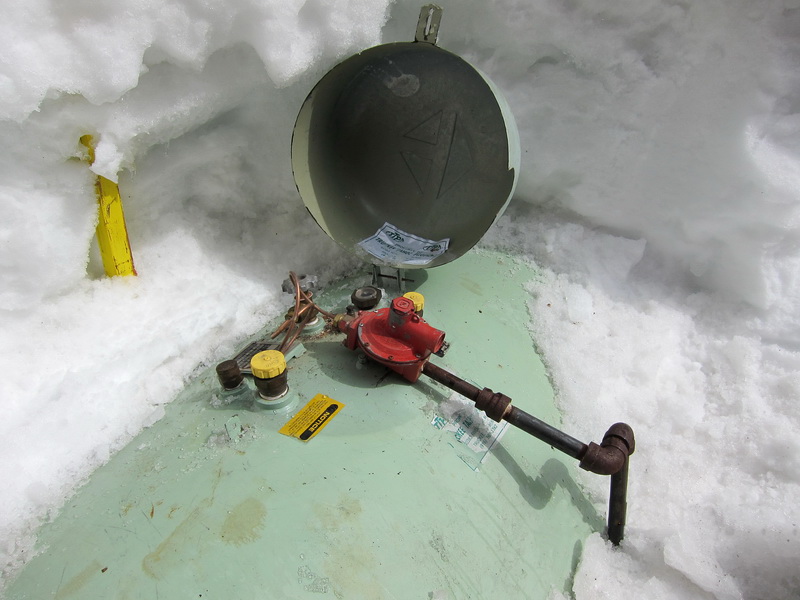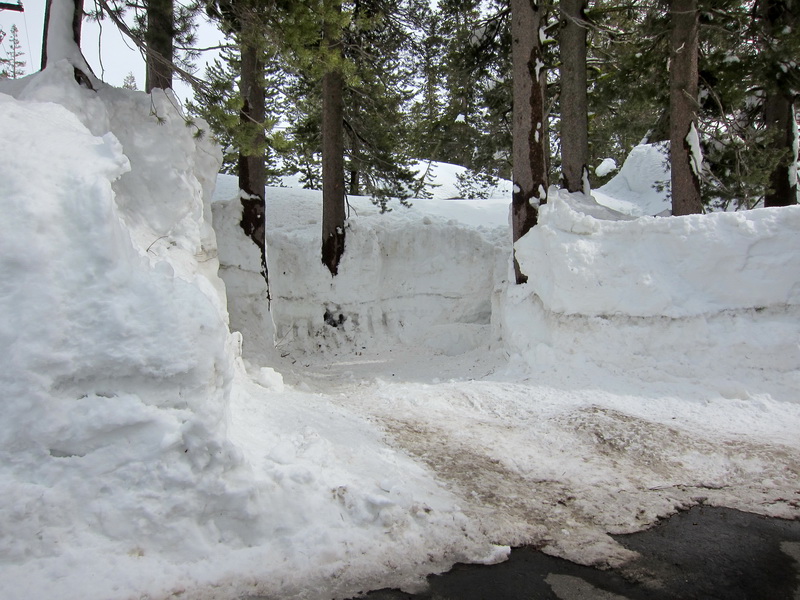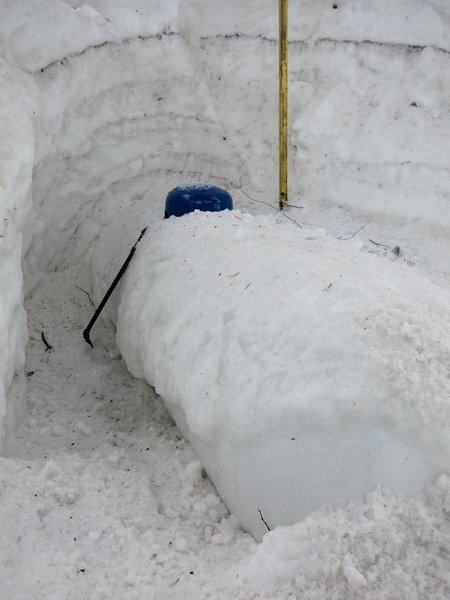Smell propane, call 911
One of the consequences of living up on the summit is there is no infrastructure for providing gas to homes. Instead each home has to provide it’s own heating fuel supply. The predominate system used on the summit utilizes propane gas stored in a 500-1000 gallon storage tank with a small number of homes using heating oil or just a wood stove. You can see these tanks all over the summit.
Normally propane tanks are a very safe and convenient gas supply alternative in isolated areas. On the summit however, there is a serious complicating factor, snow. Because of the very heavy snowfalls, exposed propane tanks are usually covered with several feet of snow in the winter. This presents many problems to residents and makes the location of the tank critical. Many people try to hide their tanks by locating them back on their property behind trees and bushes. This is fine in the summer, but it means the tank is buried in snow in the winter and very difficult to get to. The propane supply companies do not dig out tanks. For this reason many residents locate the tank next to their driveways so that it is easy to dig into it through the snow. Many people also build covers that protect the tank or elevate the tanks on cement stands. In recent years the alternative of burying the tank completely has become popular. This solves the aesthetic concerns and the safety concerns. It is not an inexpensive alternative and can be physically difficult on many properties in the summit area.
The Danger: Unlike methane, the chief component of natural gas, propane is denser than air and will sink to the ground and will flow downhill when it leaks. If the tank on a property is located above the home (or a neighbors home), the propane can flow down into the home and pool in enclosed spaces. If enough propane leaks into a home, and there is an ignition source like a pilot light or wood stove fire, the propane can ignite with explosive power that can easily destroy a home. It is unfortunately a more common occurrence on the summit than anyone wants.
The typical propane tank setup on the summit has a regulator mounted on the outlet of the tank that is attached to a stand pipe (see photo) that goes into the ground to connect with the supply line that is deep enough to be under the frost line. The supply line travels underground to the input line to the house where the house shutoff valve is located. Problems arise when a tank becomes buried with several feet of snow. The snow will cycle through warm and cold periods and will settle often turning to solid ice around the tank. The settling and expanding and contracting due to temperature can exert significant shear force on the stand pipe and its fittings and will sometimes crack of snap a pipe. The result is the compressed propane will leak out into the snow. The snow is like a sponge and soaks up the propane. The propane will diffuse through the snow and eventually will move out of the snow and along the ground to any low spaces like a garage where it may build up and flash over if it hits an ignition source.
It is very important that residents of the summit with propane systems be aware of the dangers and monitor their systems. The best time to check a system is during the summer when things are dry. The standpipe and fittings should be inspected for wear and tear. It might be a good idea to have your provider inspect the system and suggest any repairs. It might also be a good idea to rethink the location of the tank if it is going to be inaccessible during the winter.
So what happens when there is a leak? As residents with dogs, Linda and I walk extensively around our neighborhood during the winter. On several occasions over the years we have walked by a cabin and got a strong whiff of propane. The first time it happened we didn’t really know what to do. Who do you call? We ended up calling the propane provider listed on the tank and they came up and shut it off the next day. That was the wrong thing to do. Luckily in that case the leak was minor and not much propane had leaked out. But what if it had been a big leak and the propane had leaked out all night and blew up a cabin? The next time it happened it was our next door neighbor. The problem was the tank was completely buried and we couldn’t see the tank even if we wanted to call the provider. It turned out that one of our other neighbors had called 911 and Truckee fire showed up within the hour. They dug out the very deeply buried tank and shut it off. They also advised us that if we ever smell propane, call 911 immediately. The crucial action is to get the propane shut off as soon as possible to avoid a catastrophe. By the way, if the leak is at the tank, it will do no good to shut off the valve going into the house.
Recently, there was a leak at a cabin that was occupied at the time. Fortunately, the leak was detected and fire personnel were called. As it turned out the firemen had detectors that detected high levels of propane at floor level in the cabin. The residents evacuated the cabin in the middle of the night for safety. Digging out the tank turned out to be much bigger deal. The 8-10 feet of snow under which the tank was buried was saturated with propane and was considered hazardous waste. It was necessary to bring in a remediation company to remove the snow, at the owners expense. In addition the cabin was red tagged and the owner could not reoccupy it until the snow was removed and the leak repaired. It was a big hassle for the owners although not as big as it could have been if the propane had exploded.
Hopefully this article will make residents more aware and help to prevent them from experiencing problems with their propane systems.




THANK YOU, George! It was our cabin, this past weekend, that nearly got blown to bits. And we were just about to light a fire when I realized it wasn’t a dead animal we smelled, but PROPANE. Our very own fire department came within minutes and got us and Toby our Airedale out “RIGHT NOW!!!”. We are supremely thankful …and chagrined. You can bet we will never allow our tank valves to be buried again.
A good lesson for all of us up here!!